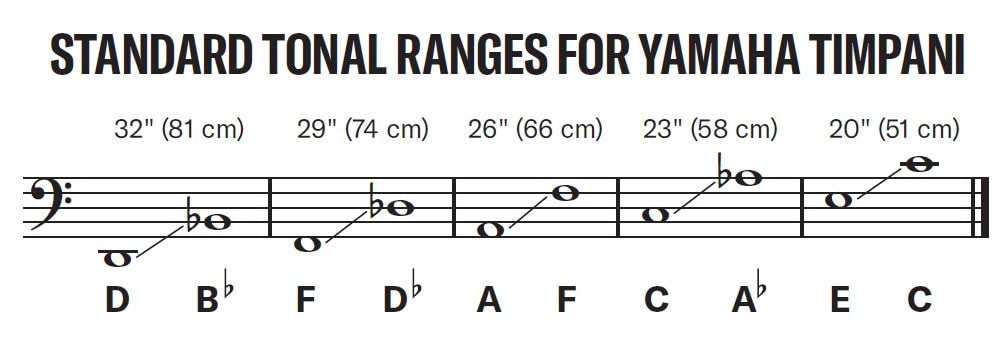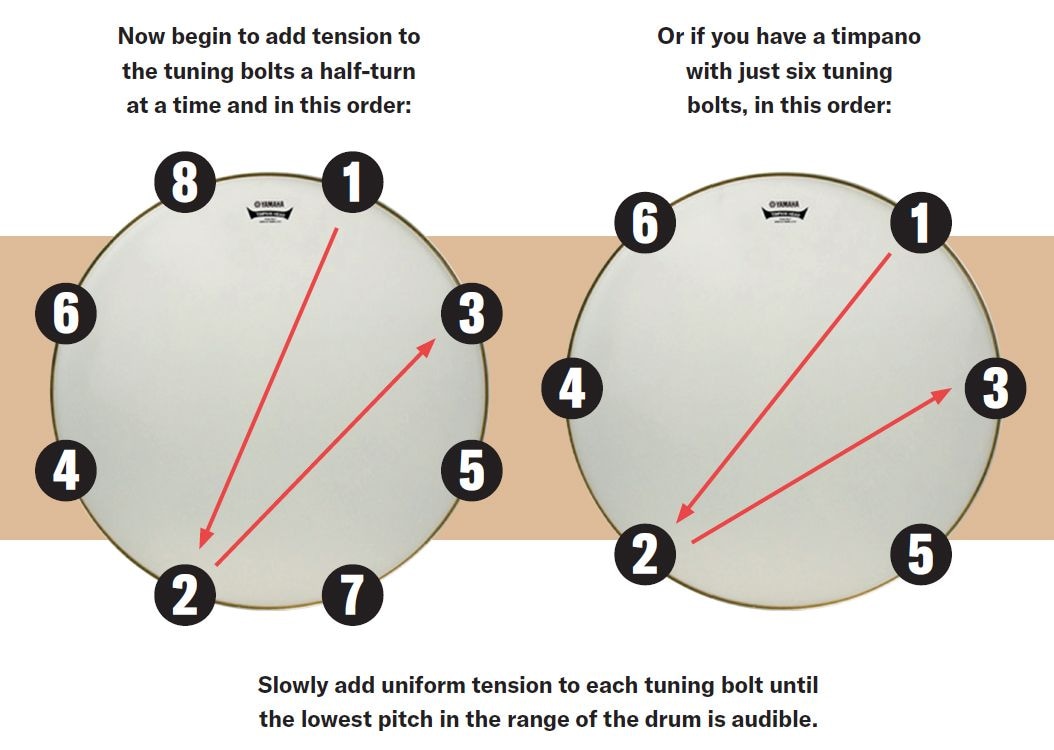A Maintenance Guide for Timpani for Non-Timpanists

You have those large, loud, heavy drums in the back of your band room, but they don’t ever seem to be in tune or be able to stay in tune. What do you do to make them more reliable?

Tuning your Timpani
Timpani have specific pitch ranges, depending on the size of the drums themselves. For your set of timpani to sound good, each drum must be tuned to its ideal range so that the pedal remains balanced across the entire range, and the pedal doesn’t flop to the top or bottom of its range of motion.
To begin the tuning and balancing processes, you’ll need a block of wood, a tuning key, and a tuning device like a tuning fork or a tuner app on your phone.
- Place the block of wood between the toe of the pedal and the base of the timpani’s frame. This will prevent the pedal from ‘flying’ up to a tight tension.
- Loosen the tuning bolts of the head so that the head is completely slack. Make sure the balance spring adjustment bolt or knob is in a neutral position and not wound too tightly or too slack.
- Ensure the head is centered in the middle of the bowl. If the head is not centered correctly, the drums will never be able to be put in tune with itself or, ‘cleared’.

Now you’re ready to CLEAR the drumhead, which is the process of making sure the drumhead is tuned to its ideal range and is in tune with itself, and all unwanted harmonics are cleared away. This process also brings the head tension into the ideal pitch range for the size of the drum.
- To begin, place a piece of cloth to act as a dampener or muffler in the exact middle of the drumhead. This will make it easier for you to hear the pitch of each tuning bolt as you move around the drum.
- Next, using a hard timpani mallet, gently strike the head very close to the no. 1 tuning bolt (see image above). Using your tuning device, verify the pitch of that tuning bolt position and adding just ½ turn of the tuning key, increase the tension of the tuning bolt.
- Employing the same steps, continue this process around all six or eight tuning bolts until the drum is nearing the top of its recommended range. Use your ear to match all the tuning bolts pitches to each other. Remember, we’re after all the tuning bolt points of impact to have the same identical pitch as each other. Uniformity of pitch is critical.
- You can also verify that the pedal is balanced by removing the block of wood and moving the pedal up and down across its range of travel to determine that the pedal stays in whatever position you leave it. If it doesn’t, your drum is not quite in its ideal range yet. Continue the steps above of introducing small but identical increases in tuning bolt tension around the circumference of the drum until the head sounds good across its range and the pedal stays in position.
- Remember, if the pedal doesn’t stay near its top position, tighten the head (increase the upper pitch range) to balance the pedal. If the heel of the pedal doesn’t stay at the bottom of its range, the pitch of the head is too high and you’ll need to loosen off some head tension.
- If the pedal is still not cooperating, you may have to make a spring tension adjustment (at the bottom of the drum frame). Proceed with caution though, as spring tension adjustments should be seen as a last resort in balancing the pedal movement.
- If the toe of the pedal won’t stay in place at the top of its travel, gradually tighten the spring tension. If the heel of the pedal won’t stay in place, gradually loosen the spring tension. I’ve highlighted the words toe, top and tighten, as a useful mnemonic for remembering which way to adjust the spring.

Timpani Hygiene
TIP 1
Keep the playing surface of the drums clean and oil free by using a spray bottle filled with water and a few drops of washing-up liquid on the heads both before and after use. This will have the added benefit of keeping oils out of the felt of the mallets used by different players, making the mallets also last longer. Drumheads are made of mylar, so this gentle homemade cleaner is safe for the heads.
TIP 2
Try to clean the superstructure of the timpani periodically, as dust and dirt, especially if the drums are used outside, can interfere with the pedal lubrication and range of motion. Again, a simple dusting of the base and pedal area can do wonders for longevity. And a gentle all-purpose spray cleaner that is safe for metals will work well on the base, struts and structure of the drums.

Larry Reese is a graduate of The Juilliard School in New York and The Royal College of Music in London. He has been the Section Principal Timpanist of the New Zealand Symphony Orchestra since 1998. During his tenure in the NZSO, Larry has played on over 70 commercial recordings on the Sony, Rattle, Naxos and EMI labels, with total sales of over one million records. The NZSO earned their first Grammy nomination for Best Orchestral Performance in 2015 for a recording of Pulitzer Prize-winning composer Zhou Long’s Symphony ‘Humen 1839’.
